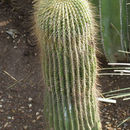zh-TW
在導航的名稱


Cephalocereus polylophus ist eine Pflanzenart aus der Gattung Cephalocereus in der Familie der Kakteengewächse (Cactaceae).
Cephalocereus polylophus wächst einzeln und erreicht Wuchshöhen von bis 13 Metern. Die säulenförmigen Triebe sind anfangs hellgrün und werden im Alter dunkler. Sie weisen Durchmesser von bis 50 Zentimetern auf. Die 22 bis 36 (selten ab 10) schmalen, leicht bogigen Rippen sind durch eine scharfe Furche voneinander getrennt. Der einzelne, biegsame Mitteldorn, der auch fehlen kann, ist häufig kürzer als die sieben bis acht Randdornen. Die Randdornen sind ebenfalls biegsam und 1 bis 2 Zentimeter lang. Sie sind gelblich bis bräunlich und vergrauen mit zunehmendem Alter.
Die Blüten erscheinen meist in Gruppen in der Nähe der Triebspitzen. Sie sind dunkelrot, 4 bis 6 Zentimeter lang und erreichen Durchmesser von 3 bis 3,5 Zentimeter. Ihr Perikarpell und die Blütenröhre sind mit ziemlich großen Höckern und kleinen Schuppen, die in den Axillen kahl sind, besetzt. Die eiförmigen, grünen Früchte sind 2,4 bis 4 Zentimeter lang und mit Schuppen, Wolle und Borsten besetzt.
Cephalocereus polylophus ist in den mexikanischen Bundesstaaten Hidalgo, Querétaro, Guanajuato und San Luis Potosí verbreitet.
Die Erstbeschreibung als Cereus polylophus erfolgte 1828 durch Augustin-Pyrame de Candolle.[1] Nathaniel Lord Britton und Joseph Nelson Rose stellten die Art 1909 in die Gattung Cephalocereus.[2] Weitere nomenklatorische Synonyme sind Pilocereus polylophus (DC.) Salm-Dyck (1845), Neobuxbaumia polylopha (DC.) Backeb. (1941), Carnegiea polylopha (DC.) D.R.Hunt (1988) und Carnegiea polylopha (DC.) P.V.Heath (1992).
In der Roten Liste gefährdeter Arten der IUCN wird die Art als „Vulnerable (VU)“, d. h. als gefährdet geführt.[3]
Cephalocereus polylophus ist eine Pflanzenart aus der Gattung Cephalocereus in der Familie der Kakteengewächse (Cactaceae).
Neobuxbaumia polylopha is found only in Mexico and is confined to a small area in the state of Guanajuato. It grows only in canyons with limestone slopes, similar to the cacti Neobuxbaumia multiareolata, Neobuxbaumia sanchezmejunadae, and Neobuxbaumia squamulosa. Neobuxbaumia polylopha is not well known among locals and has no local uses.[1] However, it is popular among cactus enthusiasts and reproduces well in nurseries.[2]
The common names of Neobuxbaumia polylopha are the cone cactus, golden saguaro, golden spined saguaro, and wax cactus. Polylopha means many ribs. Neobuxbaumia polylopha also has many synonym scientific names due to being reclassified. The synonyms include Cereus polylophus, Pilocereus polylophus, Cephalocereus polylophus, and Carnegiea polylopha. It was classified as being part of the Stenocerinae subtribe of the Pachycereeae in 1975 by Buxbaum.[3]
The form of Neobuxbaumia polylopha is a single large arborescent stalk. It can grow to heights of over 15 meters and can grow to weigh many tons.[4][5] The pith of the cactus can be as wide as 20 centimeters.[6] The columnar stem of the cactus has between 10 and 30 ribs, with 4 to 8 spines arranged in a radial manner. The spines are between 1 and 2 centimeters in length and are bristle like.
The flowers of Neobuxbaumia polylopha are a deeply tinted red, a rarity among columnar cacti, which usually have white flowers.[7] The flowers grow on most of the areoles. The areoles that produce flowers and the other vegetative areoles on the cactus are similar. The areoles produce flowers for many years. Flowers open up during the day and are pollinated by insects. The fruits are small and green, and cylindrical in shape. Seeds grow quickly, and can germinate in three weeks. They are exposed to allow the birds to eat them quickly. Fruits that are not eaten fall off and dry up. The fruits are edible to humans and have a delicate, nutty flavor.[8] The growth of the population depends more on how many seedlings survive rather than on the growth and reproduction of older plants.[9]
Neobuxbaumia polylopha is found only in Mexico and is confined to a small area in the state of Guanajuato. It grows only in canyons with limestone slopes, similar to the cacti Neobuxbaumia multiareolata, Neobuxbaumia sanchezmejunadae, and Neobuxbaumia squamulosa. Neobuxbaumia polylopha is not well known among locals and has no local uses. However, it is popular among cactus enthusiasts and reproduces well in nurseries.
Neobuxbaumia polylopha (DC.) Backeb. es una especie de planta fanerógama de la familia Cactaceae.
Neobuxbaumia polylopha crece individualmente y alcanza un tamaño de hasta 13 metros de altura. Las tallos en forma de columnas son inicialmente de color verde y más oscuro con la edad. Tiene un diámetro de hasta 50 centímetros. Las 22 a 36 (raramente 10) estrechas costillas, ligeramente arqueadas están separadas una de otra por un pliegue agudo. La única, flexible espina central, puede estar ausente, es a menudo más corta que los siete u ocho espinas radiales. Las espinas son también flexibles y de 1 a 2 cm de largo de color amarillento a marrón y se vuelven grises con la edad. Las flores suelen aparecer en grupos cerca de las puntas de los brotes, son de color rojo oscuro, de 4 a 6 cm de largo y alcanzan un diámetro de 3 a 3,5 centímetros. Su pericarpo y las flores son tubulares con pequeñas escalas. Las frutas tienen forma de huevo, son verdes de 2,4-4 cm de largo y cubiertas de escamas, lana y pelos.
Es una planta arbolada perenne carnosa columnar, armada de espinos, y con las flores de color rojo.
Neobuxbaumia polylopha fue descrita por (DC.) Backeb. y publicado en Blätter für Kakteenforschung 6. 1938.[2]
Neobuxbaumia: nombre genérico que es otorgado en honor de Franz Buxbaum, lleva el prefijo neo = "nuevo" para distinguirlo de Buxbaumia un género de musgos.
polylopha: epíteto latíno compuesto que significa "con muchas crestas"[3]
Neobuxbaumia polylopha (DC.) Backeb. es una especie de planta fanerógama de la familia Cactaceae.
Neobuxbaumia polylopha là một loài thực vật có hoa trong họ Cactaceae. Loài này được (DC.) Backeb. mô tả khoa học đầu tiên năm 1938.[1]
Neobuxbaumia polylopha là một loài thực vật có hoa trong họ Cactaceae. Loài này được (DC.) Backeb. mô tả khoa học đầu tiên năm 1938.